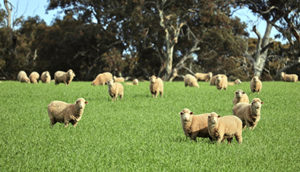Read the latest information on
Foot-and-mouth disease

Much like the flu in human populations, many biosecurity risks to your farm are tied to seasonal conditions. Shifting wind patterns, rainfall and temperature can impact where we find pests, weeds, and both diseases and things which can spread them.
With meteorologists suggesting that the coming seasons may be wetter than average, Animal Health Australia (AHA) is reminding livestock producers to pay close attention to what’s going on in their region as the weather changes.
“Diseases like footrot, or those spread by insects such as three-day sickness, are more prevalent when your country is warmer and wetter,” says Dr Simon Humphrys, Executive Manager Biosecurity at AHA.
“On the other hand, conditions like pneumonia and anthrax tend to turn up when it’s drier and dustier; as one risk factor decreases, another is likely to increase.”
A recent detection of bluetongue virus (BTV) occurred during routine monitoring of a sentinel herd in the Shoalhaven region of NSW. The area had been in the BTV transmission free zone for a number of years, and is just one example of the fluid nature of the distribution of diseases and their vectors.
Unfortunately, many biosecurity threats are unpredictable, but they are tied to the ability of seeds, vectors or disease agents to survive prevailing conditions after which they can be moved around opportunistically.
“This makes many diseases, pests and weeds seasonally predictable year on year; but that seasonal cycle is based on longer-term conditions too, and that’s the rub, they seem to be more variable,” Dr Humphrys explained.
“So, a region might be ‘free’ of a particular problem for a couple of years, and then have a resurgence in cases when the conditions are right.”
Though state and territory governments track detections and collect data on trade-sensitive pests and diseases, the disease surveillance system relies on accurate reports from producers and landowners, especially those on the fringes of known distribution areas.
This becomes especially important when dealing with an incursion of an exotic species of insect or disease. When we talk about an incursion, what that means is that something has turned up where it hasn’t been seen for a while, or ever.
“Sometimes, this simply means a disease or pest is spreading beyond what we understood its natural boundaries to be,” said Dr Humphrys.
“Other times, it could trigger a biosecurity emergency response, if it turns out to be something which is entirely new to Australia and which would be bad for our animals or the environment.”
If you spot something on your property that you haven’t seen before, or haven’t seen for a while, it’s best to report it to your state or territory’s department of agriculture or primary industries.
If you spot something you think might be an emergency animal disease you can report it to the national hotline:
EAD Watch Hotline: 1800 675 888
Find out more about monitoring your crops, livestock and property for diseases, pests and weeds at Farm Biosecurity.